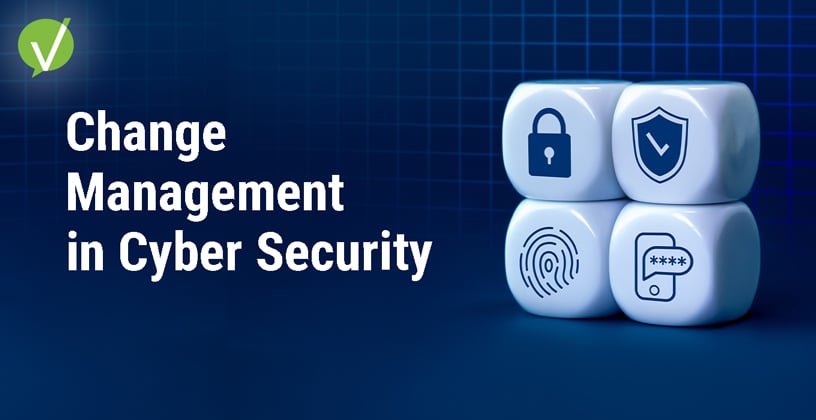What is Change Management in Cyber Security? System Integrity
Introduction
In this blog, we will explore the concept of change management in cyber security and its importance in maintaining system integrity. Change management is a structured process that organizations implement to handle system or service changes related to information security. By effectively managing these changes, businesses can mitigate security risks, adapt to new cyber threats, and ensure the smooth implementation of cybersecurity initiatives.
The change management process involves a systematic approach to making changes to an organization’s cybersecurity posture. This includes conducting risk assessments, implementing cybersecurity measures, and using a change advisory board to oversee the change process. Effective change management practices are vital to maintaining an organization’s security and risk management protocols.
Key Takeaways
- The change management process is a structured approach to handling system or service changes related to cyber security.
- Effective change management practices are critical to maintaining an organization’s security posture.
- Risk assessments and cybersecurity measures are key components of the change management process.
- The Change Advisory Board (CAB) plays a critical role in overseeing the change process.
- Change readiness is an essential factor in ensuring successful change management in cyber security.
Understanding Change Management in Cyber Security
In the realm of cybersecurity, change management emerges as a critical cornerstone of organizational security and risk management. This structured process involves implementing requested changes to an organization’s network or system while upholding stringent security controls to mitigate potential risks.
The following table offers a concise overview of change management in cybersecurity. Embracing these principles empowers organizations to strengthen their cybersecurity posture, minimize security incidents, and reinforce defenses against emerging threats.
Aspect |
Description |
|---|---|
| Definition | Change management in cybersecurity involves implementing requested changes to an organization’s network or system while maintaining security controls to mitigate potential security risks. |
| Structured Process | Effective change management follows a structured process that includes a thorough risk assessment of the requested change. It also includes the creation of a change request document detailing the purpose, scope, and implementation plan. |
| Proactive Approach | Proactive change management in cybersecurity is essential for mitigating security risks related to cyber threats. It allows organizations to adjust their security posture to eliminate vulnerabilities. |
| Key Stakeholders | Change management involves key stakeholders, including the Change Advisory Board, to oversee the change process and ensure alignment with organizational security processes. |
| Benefits | Effective change management reduces the likelihood of security incidents and network outages caused by poorly implemented changes. It keeps employees informed about emerging threats and cybersecurity initiatives. |
With effective change management in place, organizations can significantly reduce the likelihood of security incidents and eliminate network outages caused by poorly implemented changes. Additionally, change management helps to ensure that employees stay informed about emerging threats and cybersecurity initiatives, ultimately improving an organization’s overall cybersecurity posture.
The Process of Change Management in Cyber Security
Cybersecurity measures are essential for any organization to safeguard against security breaches. However, it is equally important to have effective change management practices in place to ensure security is maintained during the change process. Management is the process of planning, organizing, and controlling resources to achieve a specific goal. Change management is a structured process that ensures security processes are followed when implementing requested system or service changes.
Change Management Practices |
Security Controls |
|---|---|
|
|
The above table highlights some of the best change management practices and security controls that businesses should adopt to maintain their cybersecurity posture.
To sum up, effective change management is a critical aspect of maintaining a robust cybersecurity posture. Organizations must implement the change management process as a structured approach to ensure that cybersecurity measures stay up to date with new and emerging threats. Change management ensures that employees are educated, the requested change is carefully considered, and potential risks are adequately identified before implementing the latest and greatest technology tools.
The Role of Change Advisory Board in Cyber Security
If you want to ensure cybersecurity, you need to pay attention to the role of a Change Advisory Board (CAB). The CAB plays a critical role in overseeing the change process in your organization to ensure the implementation of cybersecurity measures. To align with your security and risk management protocols, you must establish a robust change management plan that helps you manage those changes.
The change management process occurs when an organization wants to make a change to its technology infrastructure or other asset related to information security. For a proper implementation of cybersecurity measures, cybersecurity professionals must approve all changes to your system, including those to your network. Security incidents often happen due to misconfiguration resulting from a new change that opens a vulnerability in the network. To reduce the risk, the CAB should ensure that all requested changes to your organization’s technology infrastructure pass through the proper change process.
To stay on top of changes, the CAB needs to be fully informed of new and emerging cybersecurity threats. It must stay informed about potential risks that may come with implementing the latest and greatest cybersecurity technology tools. The CAB must be equipped to manage those risks effectively, so your employees stay informed and educated about cybersecurity measures, such as zero trust, while they are using cloud services. This constant state of flux demands a CAB with persistence and focus.
Benefits of Change Management in Cyber Security
Effective change management is critical to the success of your cybersecurity initiatives. With a proactive approach, security controls can be put in place to protect against potential threats. This ensures that your organization is adequately prepared for any breach or cyber attack, significantly reducing your security risks.
The change management process ensures that system or service changes are implemented efficiently and consistently while addressing security concerns. By following this structured process, your organization can maintain the integrity of your security processes and controls while rapidly addressing change requests.
Moreover, effective change management enables your organization to implement the latest and most innovative cybersecurity measures, keeping up with new and emerging threats. It also ensures that your employees are educated on the potential risks of cyber attacks and that they stay informed about emerging threats.
Benefits of Change Management in Cyber Security |
Description |
|---|---|
| Better implementation of cybersecurity initiatives | Effective change management ensures that your cybersecurity initiatives are implemented efficiently and consistently. |
| Reduced security risks | A proactive approach to cybersecurity ensures that security controls are in place to protect against potential threats, significantly reducing your security risks. |
| Improved agility | By following the change management process, your organization can rapidly respond to change requests and keep up with new and emerging threats. |
Effective change management is a critical aspect of your cybersecurity posture. By implementing proactive change management practices, your organization can maintain the integrity of security processes while ensuring that your cybersecurity initiatives are implemented efficiently and effectively.
The Human Element: Change Readiness in Cyber Security
Change management is crucial for organizations as they integrate new technology and processes into their infrastructure. However, the human aspect of cybersecurity often gets overlooked during this transition. As a cybersecurity professional, maintaining a constant state of readiness is paramount before implementing any requested changes.
Incorporating a zero-trust approach to cybersecurity is instrumental in preserving security, especially when incorporating cloud services into your infrastructure. Prior to utilizing cloud services, it’s essential to establish robust security controls and evaluate their potential impact on your security posture.
Effective change management practices encompass identifying potential security risks, assessing their implications, and devising mitigation plans in collaboration with relevant stakeholders. It’s imperative to maintain transparency and accountability by communicating potential risks to stakeholders throughout the change process.
Software can play a crucial role in supporting change management in cybersecurity by automating risk assessments, tracking security controls, facilitating communication with stakeholders, and ensuring that security remains intact during the integration of new technologies and processes.
Change Readiness Checklist
Actions |
Details |
|---|---|
| Educate Employees | Provide cybersecurity training to ensure employees are aware of potential risks involved with change management and how to identify potential threats. |
| Assess Potential Risks | Conduct a risk assessment to identify potential cybersecurity threats and assess their impact. |
| Establish Mitigation Plan | Based on the risk assessment, develop a mitigation plan with stakeholders involved. |
| Implement Zero-Trust Principles | Adopt a zero-trust approach to cybersecurity, ensuring security controls are in place prior to implementing the requested changes. |
| Stay Informed about Emerging Threats | Stay informed about the latest cybersecurity threats and updates to technology tools to ensure a constant state of readiness. |
Rise to the Challenge: Effective Change Management in a Dynamic Cyber Landscape
By following the checklist and leveraging appropriate software solutions, organizations can enhance their change management practices in cybersecurity, reduce security risks, and maintain a high level of security preparedness.
- Thorough Risk Assessment
- Conduct a comprehensive risk assessment before implementing any changes.
- Utilize cybersecurity software for automated risk analysis and identification.
- Employee Education and Awareness
- Ensure that employees are well-informed about upcoming changes and associated risks.
- Employ cybersecurity training software for educating employees on cybersecurity best practices.
- Incorporate Change Management into Cybersecurity
- Recognize change management as a critical component of cybersecurity initiatives.
- Implement change management software to streamline processes and maintain compliance.
- Preventing Breaches and Ensuring Compliance
- Develop a well-defined and efficiently executed change management plan to prevent breaches.
- Utilize cybersecurity software for continuous monitoring and compliance assurance, even during challenges like the Covid-19 pandemic.
- Stay Informed About Emerging Threats
- Stay vigilant by keeping up-to-date with the latest technology tools and cybersecurity developments.
- Employ threat intelligence software to stay ahead of potential risks and enhance security measures.
- Human Element and Employee Readiness
- Focus on the human element of change management by educating employees.
- Utilize cybersecurity awareness and training software to prepare employees for adaptation.
- Implement Cutting-edge Cybersecurity Measures
- Incorporate advanced cybersecurity measures to proactively safeguard against breaches.
- Leverage cybersecurity software solutions to automate risk assessments, enhance security, and facilitate employee education, ensuring a state of readiness for evolving cybersecurity challenges.
For over two decades, Vivantio has been assisting cybersecurity professionals in embracing a dynamic and agile approach to change management. Staying updated on emerging cybersecurity trends and technologies empowers security teams to lead organizational transformation, ultimately establishing a sustainable competitive advantage.. To find out how Vivantio can help you improve your change management in cybersecurity, contact our team today or register for a free demo.













